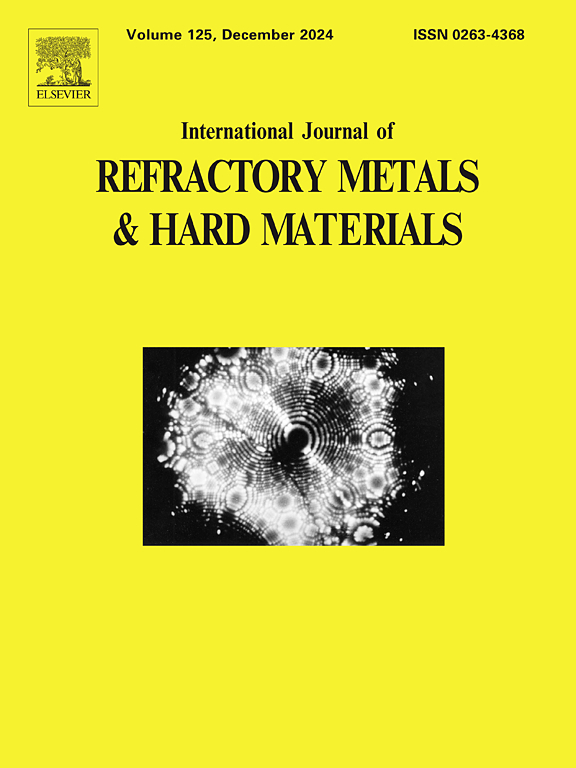碳还原法合成中间价钨氧化物及其在过氧化氢中的溶解行为
IF 4.2
2区 材料科学
Q2 MATERIALS SCIENCE, MULTIDISCIPLINARY
International Journal of Refractory Metals & Hard Materials
Pub Date : 2025-04-16
DOI:10.1016/j.ijrmhm.2025.107191
引用次数: 0
摘要
本研究提出了一种钨屑的无氨回收方法,即将废碳化钨初步氧化,还原为中间价钨氧化物,然后在过氧化氢中溶解,生成有价值的钨产品前驱体过氧钨酸(PTA)。研究强调在碳还原过程中稳定中间价钨氧化物,以获得更高的过氧化氢溶解效率。实验结果表明,控制焙烧条件可有效调节氧化程度,优化碳还原参数可保证中价钨氧化物的稳定生成。溶解实验进一步证实,二氧化钨(WO2)由于其高溶解度和相对较低的过氧化氢消耗而成为最佳前驱体。在优化的碳还原条件下(1000°C, WO3:C摩尔比为1:2),工艺改进使溶解率超过97%,确保了钨的有效回收,同时减少了过氧化氢的消耗。本文章由计算机程序翻译,如有差异,请以英文原文为准。

Synthesis of intermediate-valence tungsten oxides via carbon reduction and their dissolution behavior in hydrogen peroxide
In this research, an ammonia-free recycling method for tungsten scraps is proposed, involving the preliminary oxidation of waste tungsten carbide, reduction to intermediate-valence tungsten oxides, and subsequent dissolution in hydrogen peroxide to produce peroxotungstic acid (PTA), a valuable precursor for tungsten products. The study emphasizes stabilizing intermediate-valence tungsten oxides during carbon reduction to achieve higher dissolution efficiency in hydrogen peroxide. Experimental results demonstrate that controlling the roasting conditions effectively regulates the degree of oxidation, while optimization of carbon reduction parameters ensures stable formation of intermediate-valence tungsten oxides. Dissolution experiments further confirm that tungsten dioxide (WO2) serves as an optimal precursor due to its high solubility and relatively low hydrogen peroxide consumption. Under optimized carbon reduction conditions (1000 °C, WO3:C molar ratio of 1:2), process enhancements enabled a dissolution rate exceeding 97 %, ensuring efficient tungsten recovery while reducing hydrogen peroxide consumption.
求助全文
通过发布文献求助,成功后即可免费获取论文全文。
去求助
来源期刊
CiteScore
7.00
自引率
13.90%
发文量
236
审稿时长
35 days
期刊介绍:
The International Journal of Refractory Metals and Hard Materials (IJRMHM) publishes original research articles concerned with all aspects of refractory metals and hard materials. Refractory metals are defined as metals with melting points higher than 1800 °C. These are tungsten, molybdenum, chromium, tantalum, niobium, hafnium, and rhenium, as well as many compounds and alloys based thereupon. Hard materials that are included in the scope of this journal are defined as materials with hardness values higher than 1000 kg/mm2, primarily intended for applications as manufacturing tools or wear resistant components in mechanical systems. Thus they encompass carbides, nitrides and borides of metals, and related compounds. A special focus of this journal is put on the family of hardmetals, which is also known as cemented tungsten carbide, and cermets which are based on titanium carbide and carbonitrides with or without a metal binder. Ceramics and superhard materials including diamond and cubic boron nitride may also be accepted provided the subject material is presented as hard materials as defined above.

 求助内容:
求助内容: 应助结果提醒方式:
应助结果提醒方式:


